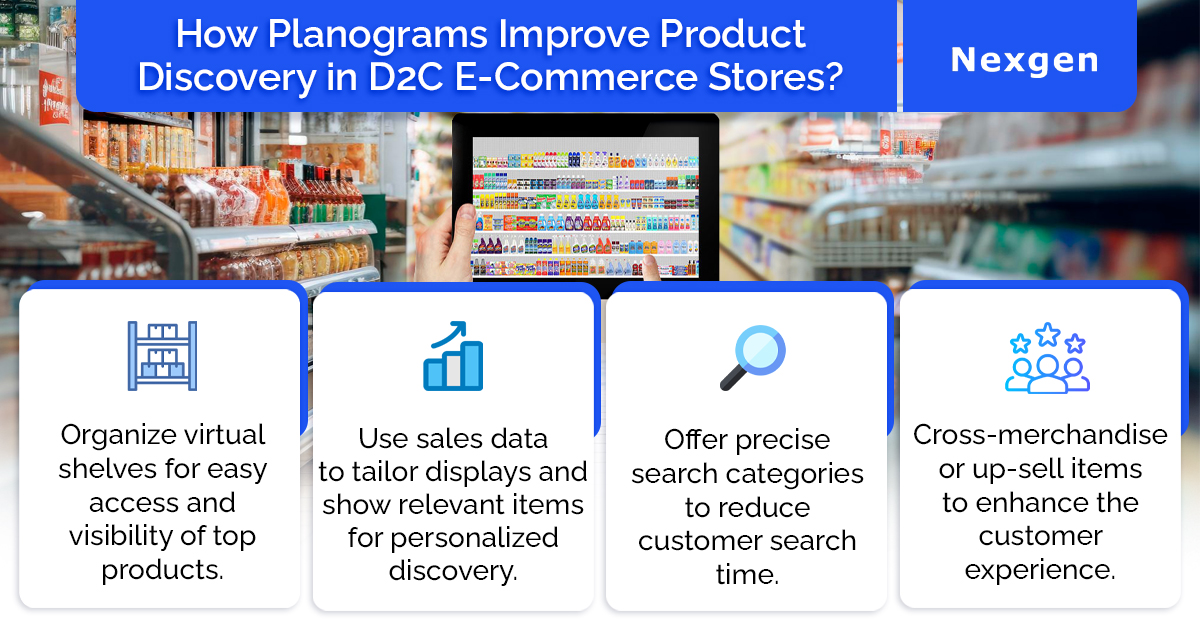In today’s e-commerce landscape, product discovery plays a pivotal role in determining customer engagement and conversion rates. With thousands of products vying for attention, a seamless and intuitive shopping experience can make all the difference. This is where planograms, traditionally associated with brick-and-mortar stores, have found their place in the digital market. For D2C e-commerce brands, leveraging planogram principles can significantly enhance how customers find and interact with products online. Here is how planograms can elevate product discovery in D2C e-commerce stores:

1. Structured product layout for optimal browsing.
One of the main benefits of planograms is their ability to create a well-organized product layout. In physical stores, this translates to efficient shelf organization. Online, it means designing an intuitive product categorization system that mirrors the in-store experience. By utilizing shelf space planning concepts, D2C stores can categorize products logically, making it easier for customers to browse through offerings based on categories, features, or popular items.
For example, if a customer is shopping for skincare products, a well-organized e-commerce store could offer product recommendations based on skin type, concern (e.g., anti-aging, hydration), and best-sellers. The clear structure enables quick navigation, leading customers toward the right products without feeling overwhelmed by options.
2. Enhanced visual merchandising.
In a physical store, visual merchandising is critical to driving impulse buys and improving customer experience. Similarly, in e-commerce, product discovery is driven by visually appealing layouts and strategic placements. Planograms help brands map out where products should be displayed online, ensuring that the most relevant items are placed prominently on homepages, landing pages, or category listings.
For instance, a D2C fashion brand could use planogram principles to highlight trending items, or limited time offers at the top of their online store, increasing visibility and driving sales. This can also be done dynamically, allowing featured products to rotate based on seasonal trends or customer browsing behavior, creating a personalized shopping experience.
3. Personalized product recommendations.
Planograms in e-commerce can take on a digital form through personalized algorithms that suggest products based on previous shopping behaviors. By mimicking a planogram's organized shelf space, D2C brands can create virtual shelves tailored to individual shoppers, showcasing items that match their preferences. Whether through “Customers also bought” or “You may also like” sections, planogram-inspired algorithms help guide users toward products that interest them most.
This level of personalization not only helps in product discovery but also increases the likelihood of repeat purchases, as customers feel the shopping experience is curated just for them.
4. Streamlined search and filter functions.
Effective planograms emphasize ease of product discovery by reducing the time customers spend looking for items. This concept can be applied to e-commerce search and filter functionalities. A robust search system is vital in helping customers find exactly what they need quickly. By integrating planogram concepts, e-commerce stores can offer precise search categories, filters, and sorting options that mimic the in-store shopping experience.
Imagine a D2C electronics store allowing customers to filter by brand, specifications, and price range, akin to walking down a specific product aisle in a physical store. This targeted approach makes the shopping experience more efficient and enjoyable, leading to higher conversion rates.
5. Driving product discovery with cross-selling and up-selling.
In a well-executed planogram, complementary products are often displayed next to each other to encourage cross-selling. For e-commerce, this can be applied through strategically placed product suggestions. A D2C store can display complementary or higher-tier items during the checkout process or on product pages, improving both the customer experience and average order value.
For instance, a D2C fitness brand selling workout apparel might suggest accessories like water bottles, yoga mats, or gym bags on the same page as leggings or tops. These suggestions streamline product discovery and help shoppers find relevant products without needing to search separately.
6. Virtual reality and 3D planograms.
With the rise of immersive technologies, D2C e-commerce stores can use virtual reality (VR) or 3D planograms to offer a more engaging shopping experience. Instead of a traditional grid-style product listing, brands can create interactive product displays that allow customers to virtually “walk through” their store. This can be especially useful for product discovery, as customers can explore a curated virtual environment designed to mimic in-store product layouts.
Brands utilizing VR planograms can improve engagement and product discovery by offering a memorable, immersive experience, making it easier for customers to visualize and interact with products in a more tangible way.
Overview of Nexgen POG
Nexgen POG is a robust and user-friendly cloud-based visual merchandising tool. It is designed for quick and efficient planogramming with minimal effort. Planogram in retail can be designed by easily dragging and dropping the products. The multi-device compatibility feature of POG allows you to obtain, share and edit planogram on any device, including your phone. It helps in designing store-specific planograms for increased product visibility and sales.
Get Your Free Trial Now!